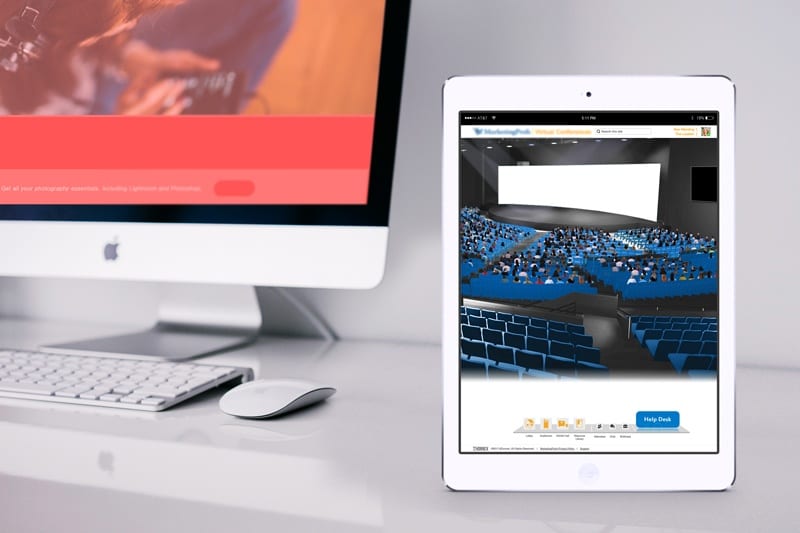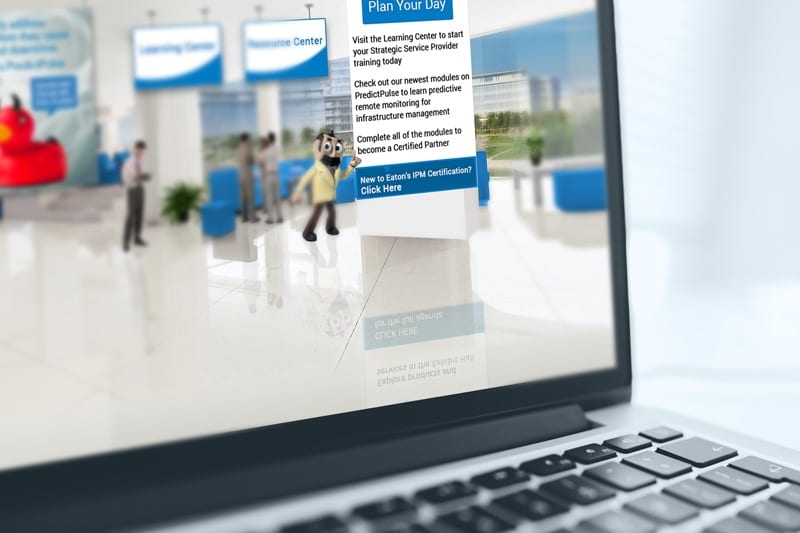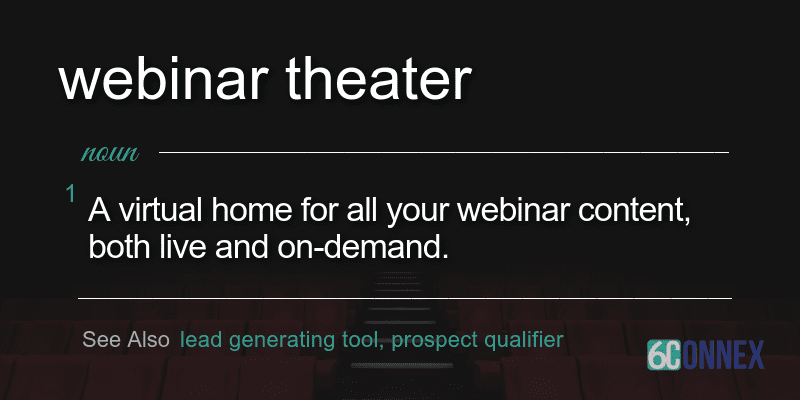Before you know it, 2021 will be here. If you haven’t yet, let us gently remind you it’s time to start planning your SKO. This has certainly been a unique year, and no doubt your team has a lot to share on lessons learned and strategies that worked and didn’t work. And in this “new normal,” you need to reinvigorate your reps to continue putting their best foot forward.
A well-done SKO will align priorities, motivate your sales team, generate energy around offers and products, and celebrate past successes. Planning it in advance is key. At 6Connex, we understand this, and because we’ve hosted hundreds of SKO events for organizations of all sizes and in all industries, we know an SKO is no ordinary sales meeting. Engaging your sales reps by delivering educational content, scheduling motivational speakers, and sharing new tools that will help them improve their efficiency requires planning. We also know that regardless of whether your SKO is virtual or physical, the recipe for success is one and the same:
1. Content, Content, Content
Organize sessions that are interesting and engaging, with information that helps your reps perform better. Review market trends. Celebrate company achievements. Publish customer testimonials. In fact, consider inviting a customer representative to present their business use case at your event. You can also invite your own sales reps to share successful approaches and experiences, and schedule panel discussions with your sales leaders to answer questions, share insights, and reflect on this unique year.
In a virtual event, sharing this content is efficient and easy. 6Connex offers webcasting tools that allow your speakers to engage with your audience, present content and videos, and interact with the audience via live Q&As. You can also launch live polls during presentations, allowing your event planners and content presenters to react to the results in real time.
In addition, it’s important – and easy – to switch presentation formats during a virtual event to maintain engagement. Be sure to mix and match individual presentations with panel discussions, Q&A sessions, engaging videos such as new product introductions, live demonstrations of solutions, etc.
2. Engage and Network at all Levels
Sales teams welcome the opportunity to interact with their peers in open forums, ask questions, provide their thoughts on business processes, and share their experiences in the field. They also love to engage with each other more informally to network and learn. This is an important part of the SKO experience, so make sure your teams have the opportunity to do this with ease.
On a virtual platform like 6Connex, we encourage our customers to create leadership lounges, where sales reps and sales enablement teams can submit questions directly to the company leadership in a fun and purposeful way. We also encourage our customers to build a sales rep lounge, where you can run multiple, moderated chats about either the session presentations or topics you believe will be of interest to your teams. These sessions bring new perspectives and generate ideas that can be leveraged by the entire organization.
It’s also important to remember to encourage colleagues to meet each other. Consider creating a “meet the team” room or wall, where your team members can share videos or pictures.
3. Celebrate your Team Members
Acknowledgement of individual and group successes goes a long way. Share achievements and shine a light on this year’s “wins.” Make sure you not only recognize those who have met or exceeded quotas, but those who have creatively dealt with challenges – your teams likely had more than their fair share in this unusual landscape!
In the 6Connex virtual environment, you can design sessions to specifically recognize team members or even create an awards room, where you can display team members’ pictures and summaries of their achievements. Including a short video from each team member accepting their award is always engaging.
Plan your 2021 SKO
If you would like to plan your virtual 2021 SKO, contact us today.
Want to learn more about planning a virtual SKO? Read how Glassdoor, one of the world’s largest job and recruiting sites, ran their 2020 SKO leveraging the 6Connex platform.

Until recently, the events industry had been slow to adopt virtual events, but in the wake of the COVID-19 outbreak, event planners are increasingly recognizing the benefits and potential of virtual formats–including improving sustainability.
Consider, for example, one of most visible impacts of in-person trade shows and industry events on the environment: waste generation. Anyone who has seen an exhibit hall following a large-scale event can attest to the large volumes of packing materials, excess publications, residual swag, flooring, and booths and structures left behind as trash. And during the event, it’s hard not to notice trash bins filled with single-use plastic bottles and service ware.
The latest statistics certainly validate these observations, suggesting tradeshows generate an incredible 600,000 tons of trash, making the trade show industry the second largest industry to produce the most amount of waste. And this is before CO2 emissions are considered. If you’re ready for more advanced math, now account for the impact of shipping, flights, and road transportation on the environment. According to MeetGreen, a sustainable events consultancy and event management company, the average three-day, 1,000-person national conference generates 584 tons of CO2 emissions, 70% of which are the result of air travel.
Then there’s water usage, the energy costs associated with air conditioning, food and beverage waste…
Are you looking for greener pastures?
The experts have long agreed that one way to radically reduce the waste and air-travel emissions produced by trade shows and industry events is to use virtual or hybrid meetings. Historically, these models were gaining traction but were far from the norm–until COVID-19 upended event calendars globally.
In the first three to four weeks following the COVID-19 outbreak, many companies scrambled to take their business events virtual. Admittedly in panic mode, these organizations were simply looking to implement tools and technology to quickly enable a global employee base to successfully work on a remote basis. Fast forward a few weeks, however, and the majority of organizations acknowledged that social distancing and other precautions weren’t a temporary state of being, but really a new normal. As a result, event planners, marketers, and business leaders re-thought their entire events strategy. It was a much longer-term discussion, and one with huge environmental benefits.
According to recent statistics, the typical virtual event with 2,300 participants reduces carbon emissions by some 3,300 tons; an estimated 17,000 trees would be needed to have a similar effect. In addition, the average number of pieces of paper saved by the use of digital documents at virtual events is 36,000 per show.
These benefits aren’t lost on event planners, exhibitors, and attendees. COVID-19 and climate change are giving stakeholders wider pause for thought and prompting questions, such as, “What is the carbon footprint of a mega trade event, with 100,000+ people travelling from all over the world to converge on one place?” and “Can this really be justified in the face of the huge challenges around global warming?”
While the health emergency is forcing companies and individuals to break barriers in order to continue to work with some semblance of normality, other factors, such as the growing awareness of the ecological impact of air travel, should hasten global adoption and further the case for remote communication and collaboration technologies long after the pandemic subsides. States 6Connex CEO Ruben Castaño, “Virtual events are not a one-time byproduct of the pandemic. With greater frequency, organizations are pivoting to virtual conferences to reduce travel costs, increase audience reach, and decrease carbon footprints.”
And the good news is that virtual events aren’t a tradeoff. Organizations don’t have to sacrifice event results for the environment. With a little planning and the right technology, virtual events can be run effectively and even increase attendee engagement rates beyond those of a physical event. Recalls 6Connex customer Glassdoor of their first virtual event, “Throughout it all, people were blown away by the environment, the branding, the colors, and the rooms. The event’s professional aesthetic was a big hit, and we received nothing but positive feedback from the attendees as well as the management team.”
Today’s pandemic is forcing industries to re-think B2B communication in ways that will long outlast the COVID-19 outbreak. Specifically, trade show cancellations and decisions to forego attendance at international exhibitions has focused attention on the long-term sustainability of such events and whether there isn’t a way to do them more efficiently and with less of an environmental impact.
Ready to kick-start your own green event strategy? Contact a 6Connex product specialist today to learn about our online event consulting services or request a demo.

6Connex, the global leader of cloud-based virtual events, today announced Luiz Martins joined the thriving software company as Chief Marketing Officer. Bringing 25 years of sales and marketing leadership experience in the technology industry, Luiz will spearhead all marketing efforts and help strengthen the brand as 6Connex continues to grow in size and expands its client base.
“From my first conversations with Ruben and the team, I was excited about the opportunity to grow the 6Connex brand. The international demand for virtual event solutions that can effectively reach customers, talent, and internal employee communities globally has been growing exponentially, and this is intensifying as companies have switched to online event formats during the pandemic. The 6Connex virtual events platform leverages state-of-the-art features and functionality to enable teams to connect with target audiences worldwide, and I’m eager to showcase the team and the technology,” commented Luiz.
Before joining 6Connex, Luiz served as VP of Global Marketing at Esko, a $1B Danaher operation, where he led a global marketing team and had direct responsibility for P&L in LATAM. He has also held leadership positions for other multinational companies such as 1WorldSync, where he developed a proven track record of driving innovation and market adoption across the technology and Software-as-a-Service (SaaS) products.
“We are excited to welcome Luiz and his impressive industry experience to our growing 6Connex team,” said Ruben Castano, CEO of 6Connex. “Since March, our virtual events business has grown by more than 20 fold and our employee team has tripled in size. We know Luiz will be an important player in our continued expansion by building more corporate awareness and strengthening our internal resources.”
Earlier in his career, Luiz was a partner and manager for a startup company funded by J.P. Morgan and Morgan Stanley. Prior to this role, he was a sales director for Mitsubishi Americas for 10 years, where he established distribution and grew the market share for technology products.
Luiz holds a bachelor’s degree in business and an MBA in marketing from Escola Superior de Propaganda eMarketing, in Rio de Janeiro, Brazil.
To meet customer needs and deliver on its aggressive product roadmap, 6Connex also hired Henry Tran as CTO in June. Henry is overseeing the company’s product strategy and development and is leading the engineering and infrastructure teams.

Keep employees up to date and informed with your business strategy and critical company updates with virtual town halls, online meetings, and virtual benefit fairs.
A global Town Hall address where regional or division employees can both receive company updates and participate in Q&A with execs.


Provides a consistent and engaging onboarding experience for geographically dispersed new hires.
Virtual benefits fair specifically focused on employee benefits. This makes the annual open enrollment process a much greater challenge.

Live and on-demand video
Keynote Auditorium
Breakout Sessions
Resource Center
True Mobile Experience
As a result of the COVID-19 outbreak, we now work in a virtual world. Meetings are virtual. Events are virtual. Training is virtual. Recruiting is virtual. In an unprecedented industry shift, companies are converging on virtual event platform providers in record numbers to deliver content to audiences–to the point where some virtual event platform providers have had to create a waitlist.

But with a deluge of complex requests, how are virtual event platform providers managing the increase in demand? And how do you choose between opposing virtual event platforms? Can you tell which vendor will be with you over the long term and which will fold after the crisis?
Following are six suggestions for determining which virtual event platform best fits your needs.
1. Will the technology actually deliver what the vendor promises? You’re pivoting to a virtual event platform on a tight timeframe. You can’t afford empty claims. Do your homework so you know exactly which features and functions are available on the market, and then create two lists: 1) “must-have” capabilities and 2) “nice to have” capabilities. This will help you determine whether the platform really meets your business needs and enable you to ignore “shiny objects.” Another key consideration: make sure the vendor can deliver on your “must have” list now, not in the future. If you learn one of your “must-have” capabilities is on a product roadmap, and not in the current product release, it’s time to move on.
2. Reputation is critical. How long has the vendor been in business? What does the vendor’s customer portfolio look like? Are some of their customers in a similar industry, of a similar size, or targeting a similar audience as you? Does the vendor have repeat customers? Can the vendor provide customer references? What is the vendor’s customer turnover rate?
3. Do not compromise on support. We can’t emphasize this one enough! When it comes to technology, things can go awry. You want to ensure your vendor is continuously doing everything possible to prevent event hiccups. The team responsible for your virtual event platform needs to be 100% invested in your event’s success and committed to their relationship with you. This type of support cannot be outsourced. It has to be in-house and you should have access to a dedicated account manager 24/7/365. Hint: when you’re checking those customer references, ask the question, “Is your support team responsive, knowledgeable, and experienced?”
4. Can the platform scale? Understand the virtual event platform’s level of customization and scalability. As you expand your audience, the platform should scale accordingly. The last thing you want is to undergo the selection and implementation process a second time because the existing platform can’t handle new or growing needs.
5. Take a test drive. Before making a final selection, kick those tires! Reputable vendors will offer a demo to showcase features, benefits, and usability. This is when you can see the platform in action and learn what it can really do. Best practice: if the platform will be used for more than one function, make sure you involve all stakeholders to participate in the demo. The platform should meet everyone’s needs (and of course you’ll want cross-departmental buy-in). Then during your demo, make sure the platform really contains your list of “must have” capabilities. Remember this isn’t just about “cool features.” It’s about meeting your requirements. Also, keep an eye on usability. As you move through the demo, take note of how many clicks or screens it takes to accomplish a specific task.
6. Insist on Key Performance Indicators (KPIs) before signing a contract. Put your new partnership to the test and collaborate with your virtual event platform provider to create Key Performance Indicators (KPIs) prior to signing any contracts. With KPIs in place upfront, both parties will know what defines a successful implementation.
Stay Focused on Creating Real ROI
Too often companies convince themselves it’s okay to down-play criteria like capability, reputation, and support in favor of a lower-quality, lesser-value platform–only to discover the platform doesn’t really meet their needs. Suddenly, they’re back to square one, perhaps even re-visiting the platform provider they should have initially selected. Following the six suggestions above will build your business case and help you identify the “best fit” platform for your business, one that offers the most value and yields a quick ROI. Have questions? Contact a 6Connex product specialist today to learn about our online event consulting services or get a demo!
Your business must go on.
But in what may be the start of a new normal for companies worldwide, your workforce is likely remote to prevent transmission of the COVID-19 virus.
The good news: you’re not alone. Globally, employers are implementing social distancing practices at the workplace. These include reducing the number of employees in the office, asking employees to work from home, prohibiting access to common areas within offices, restricting office visitors, and using virtual environments for communication and collaboration.

And even better news: there’s a wide variety of tools and technology to help virtualize office environments and enable teams to continue to work well collaboratively and simultaneously. A 6Connex Sales War Room, for example, is a fantastic virtual environment that allows sales leaders to check in anytime, anywhere to a digital command center that tracks real-time progress to goals for every business segment. Teams worldwide receive continuous deal updates and alerts, in addition to having access to an easy, virtual way to collaborate on sales activities such as scenario modeling.
Other tools, such as e-Learning, are perfect for training internal teams or customer user groups alike. At 6Connex, our e-Learning environment is user-friendly, easy to set up, and most importantly, available across a wide variety of devices and operating systems to ensure everyone on every device has equal access. Attendees receive real-time feedback during their training course, and management can get up-to-date analyses on how courses are performing, as well as track the progress of individual participants.
And on a day-in, day-out basis, companies can’t beat live event streaming as an online alternative to in-person conferences and meetings. In fact, virtual events,with deliberate planning and excellent facilitation, can be very effective, and 6Connex has been working with customers worldwide to move various AGMs, stakeholder meetings, conferences, and business events online. While the obvious benefit is that these meetings have been able to take place as scheduled, many of our customers have also been pleased to discover that in moving their events to a digital format, there are ancillary advantages including:
So if you, like many, are promoting social distancing and transitioning the meetings and events on your calendar to digital formats, here are three best practices to keep in mind:
1. Pick the right solution.
Virtual events can take many different forms, and the right virtual event provider will have multiple solutions from which to choose. For example, are you hosting a meeting? An event? A training program? When you’re planning an online event, think about what you want your user experience to look like.
Webinars
If you expect attendees to mostly just listen, a webinar is probably your best option. A webinar format is similar to a lecture or presentation. They’re ideal for sharing content with large audiences and may be open to the public. Typically, webinar attendees do not interact with one another. Though 6Connex provides features like a Q&A and polling to enable additional engagement, your average webinar adopts a ratio of one or two speakers to many attendees.
Virtual Events
On the flip side, if you’re inviting a large audience and you’re expecting more back and forth communication between them, a virtual event might be the better option. With a virtual event, you can host interactive sessions and invite lots of audience participation. You can even create an event environment with various “break out rooms,” where participants are assigned to virtual side sessions and can then reconvene for a main meeting.
Video Conferences
A web-based video conference most closely resembles a face-to-face meeting and is likely appropriate when the main purpose of your event is real-time, internal communication and collaboration. Participants can connect to the video conference from their desktop or device, and all participants can see and hear each other. Video conferencing is most useful for board meetings, company announcements, and team meetings where it’s critical for participants to see each other, present, and work as a group efficiently.
e-Learning
And if the goal of your meeting or event is training, then an e-Learning platform is probably the way to go. With e-Learning, you’re recreating the classroom environment, complete with characteristics like instructor-student interaction, Q&As, discussions, games, collaborative projects, quizzes, etc., but the instruction takes place online.
2. Be Prepared
Let’s face it: this is a best practice for any meeting regardless of whether it’s taking place in person or online. Create an agenda for your virtual meeting or event and distribute it in advance. (Tip: include it in the calendar invite.) If you’re new to virtual meetings and you’re using a virtual platform for the first time, be sure to take it out for a test drive and make sure there aren’t any connectivity issues. Also, be considerate of attendees’ different time zones and schedule the event at a time that’s reasonable for all participants. The goal is to host an effective event, and if you take time to prepare, chances are your attendees will be prepared as well and you’ll maximize your event ROI.
3. Utilize Interactive Features
No matter which platform you use or event format you choose, be sure to take advantage of all of the engagement features that come with it. For webinars, virtual events, and e-Learning in particular, tools such as chat boxes, Q&As, polls, and more are not only well received by attendees, but they allow you to track participation data so you can see how well your audience is responding to the digital format. And with social distancing required in some states for at least the next three weeks, this data will enable you to improve your digital events for the longer-term.
Options in the Wake of Coronavirus
While in-person interactions and meetings greatly contribute toward building relationships and fostering collaboration, virtual environments can go a long way to replicating this while still enforcing social distancing, whether the goal is internal communication, sharing thought leadership, or training new employees (because some of us are still hiring!).
Still have questions? Contact a 6Connex product specialist to learn about our online event consulting services or get a demo today!
On the heels of the World Health Organization’s declaration of the Wuhan coronavirus as a global emergency, some of the world’s largest trade shows have been disrupted. Sponsors and attendees alike are downgrading or withdrawing their participation, prompting event organizers to postpone and even cancel their events. Stated communications service provider Ericsson upon its withdrawal from the 2020 Mobile World Conference, “Ericsson appreciates that GSMA have done everything they can to control the risk. However, as one of the largest exhibitors, Ericsson has thousands of visitors in its hall each day and even if the risk is low, the company cannot guarantee the health and safety of its employees and visitors.”
One way event planners can guarantee the health and safety of employees and visitors: a virtual event platform. A virtual event is like a live trade show, except as the name implies, it takes place virtually, or online. Going beyond just a webinar, the technology allows individual users and businesses to enter a virtual, accessible 3D event space, where attendees can visit trade show booths, watch live webcasts, and interact with each other in chat rooms (complete with translations if necessary). They can download product sheets, presentations, and videos… at approximately 75% less than the cost of live attendance and all without the hassle of airport security, hotel check-in lines, or in the case of today’s headlines – the risk of contagion.

Even better for those companies leveraging trade shows to identify the almighty lead: virtual event visitors’ behavior is tracked, analyzed, and visualized, allowing companies to truly understand who their potential buyers are and where they may be in the buying cycle. Added bonus: these leads are available in perpetuity. With a virtual event, companies have the ability to create new sales over and over. Once they’ve built the event, they never have to break it down. They can keep using it over and over again. They’ve now established a new community.
Additional benefits include:
Wide Reach: Everyone can attend an online event, irrespective of their location. A virtual event is a great opportunity to connect with a wider, international audience and make connections with peers, prospects, and experts with whom attendees might not have crossed paths at a physical event.
Companies can also expand their reach by offering both a physical and an online experience, or a “hybrid” event. Hybrid events often draw a larger crowd, and in a hybrid event, there are more voices in the dialogue. For example, the virtual moderator can lead discussions on social media or the event platform during the event as well as interact with the live audience during a break.
And in the case of the unexpected, such as a virus outbreak, a hybrid event allows companies to choose how they would like their employees to experience the event’s content, networking opportunities, and product demonstrations. For those companies who prefer a face-to-face experience and feel comfortable allowing employees to travel, the opportunity is there. And for companies like Ericsson, who are unwilling to allow employees to travel amidst virus concerns, there’s no need to forego participation.
Cost-Effectiveness: Physical events come with a laundry list of expenses: venue rental, staff, travel, food, hotels, and entertainment. A virtual event eliminates many of these line items, not to mention speakers often charge less and registration numbers increase because everyone on a global team can attend.
Low Carbon Footprint: Compared to traditional trade shows, virtual trade shows are “greener,” and lowering environmental impact is an increasingly important goal for many companies, especially in a world where consumer buying groups are making purchasing decisions based on a company’s commitment to the environment. Tax incentives for cutting fuel costs are also likely to increase, making virtual exhibits an even more attractive proposition.
Intelligent Lead Generation: Traditional trade shows often generate exciting leads. Unfortunately, 80% of those leads are never contacted again – a statistic bound to discourage the most enthusiastic marketing professional. The reasons are myriad: disconnects between marketing and sales departments, the difficulties of reading hand-scribbled names and addresses, the tedium of entering contact information by hand into databases. However, virtual trade shows assume responsibility for collecting the data – and most include built-in lead management software. Suddenly tracking leads becomes simple. In addition, many systems offer tags so sales reps can make notes on attendees or companies, making post-event contact easy.
Also, virtual event systems generally allow companies to run analytics as soon as the show is complete. Instead of entering all of the data separately, the virtual trade show tracks and analyzes it and generates reports. Sales can chase leads immediately, which can greatly improve return on investment.
Opportunities to Connect with Next Generation Buyers: Virtual events help companies connect with the digital generation. Over time, the digital generation will comprise the majority of corporate decision makers, and this generation will be at least as comfortable with the virtual world as they are with text on a page. Gaining experience now in the virtual world will give companies an edge in marketing to this vast demographic.
Productivity: When an employee is at a trade show,he or she is out of pocket. Valuable time is spent traveling and attending the event itself. And for event sponsors, let’s face it: just putting up and taking down a booth can be a day’s work in itself. A virtual event, however, allows the employee to visit and revisit the experience on their own terms, increasing the attendee’s productivity, the conference’s value for the attendee, and its ROI for the event producer. And virtual events tend to be faster paced than those in real life since the attendees don’t have to physically move from space to space. This means attendees can actually meet more people.
The Search is Over
As companies strive to protect the health and safety of their employees as well as the employees of their customers, partners, and vendors, they’re taking all necessary measures to ensure no one is put at risk: restricting travel, limiting the size of meetings, providing remote-work solutions, and continuing to insist on safe behavior in every environment. One easy and safe way to conduct “business as usual” in this environment is through the use of virtual events. To learn more about how you can leverage virtual event technology in your own organization, request a demo today.
Virtual event planning software is clearly on the rise, with lead generating virtual events consistently proving themselves as the most powerful weapon in the digital marketing arsenal.
With such powerful results, multi-sponsor marketing events that have always been predominantly physical are now turning into virtual summits. Companies are learning how to connect with attendees through virtual booths and sponsored sessions.
But all of this commotion begs the question… what are the real differences between physical and virtual events?
For those of you thinking about replacing a physical event with a virtual event, here is the definitive pro-con list of physical vs. virtual events from the perspective of a virtual event insider.
For visual learners, here is a handy infographic summing it all up. If you need a more elaborate breakdown, scroll down a bit more.
In this section, we are going to breakdown the biggest differences between virtual events and physical events, weighing both the pros and cons of each difference.
One of the best parts of an in-person event is coincidentally one of the most expensive: travel.
Traveling to a new city or stomping ground is exciting and can help employees shake the daily grind, but it is also extremely costly. Costs for physical events include the following:
… you get the picture.
There is definitely something to be said for changing it up and giving attendees a memorable experience in a new city, but it’s going to cost you.
Fortunately, there is a simple alternative.
Virtual event companies offer “virtual venues”, 2D or 3D event spaces that can accommodate all of your employees and guests, no matter where they are in the world (and if you have a battle-tested virtual platform provider like 6Connex, you can even invite the entire internet if you so please).
But wait, it gets better…
In-demand speakers will agree to speak for a fraction of the price at virtual events because of the convenience. You can afford better speakers (and more of them) for the same price.
What does that mean? For marketing events, more high-quality speakers translate into more potential leads.
Bottom line – virtual events are more cost-effective but do not have the benefits (or setbacks) of travel.
Our workforces have gone global. Our employees are in every corner of the globe, and more and more of them are working remotely.
How do we accommodate our growing workforce?
Virtual event solutions have emerged to solve the problem of different time zones and varying schedules.
As exciting as travel is for employees, the time it takes to plan, fly (often internationally), and drive to the hotel can amount to excessive “dead” time where emails pile up and calls get pushed – not to mention the time blocked off on the calendar for the conference itself.
And what if some people can’t make it?
Physical conferences sometimes provide access to the presentation decks after the event and sometimes offer recorded sessions for later viewing. But in general, once it’s done, it’s done.
Smart companies run virtual conferences with the idea that attendees will come back again and again.
Maybe there were too many great sessions playing at the same time, or attendees want to grab some collateral to share with their CEOs. Whatever the need, virtual event attendees can revisit the experience on their own terms, increasing the conference’s value for the attendee and its ROI for the summit producer.
The flexibility medal goes to virtual.
At in-person events, whether internal or external, the extent of the data collected is usually a handwritten sign-in cheat.
Virtual events, on the other hand, are master data-miners.
Hot leads leave all kinds of clues into their buyer journey – what type of content they’re viewing, which sales reps they’re talking to, which attendees they’re engaging with, and what resources they’re downloading.
The best part? All exhibitors can access this data, grow their e-mail lists, and nurture leads better than ever before.
If you want big data, go virtual.
The battle royale of Face-to-Face vs. Interface-to-Interface.
In a world where we spend so much time online, sitting in front of our laptops or staring down at our mobile phones, it’s nice (even special) to look someone else in the eyes when you say hello.
Meeting people in person that you’ve only ever spoken to on the phone or via email adds an important layer to the relationship, allowing for a different kind of communication.
Although virtual event providers have advanced chatting technology, making it exciting and engaging for attendees to chat within the event, the world still needs handshakes.
However, over in the buying experience department, networking can actually be easier virtually.
Let me explain.
Attendees are generally interested in seeing what vendors have to offer. There are tons of tools out there that we don’t yet know about, and by chatting it up with booth reps on a virtual events platform, we can learn a lot about what’s new and what’s possible, all without feeling the pressure of buying anything.
Finally, let’s be honest… we don’t REALLY want to chat with everyone.
At a physical event, we often avoid eye contact or try to browse datasheets while dodging overzealous sales reps. In virtual summits, we can take our time and browse what we want when we want. It is a much more relaxing experience.
Bottom line – no chat box will beat a real handshake, but uninhibited sales inquiries are often better for business. If you’re curious about taking your next exhibition online, learn more about virtual trade shows.
I admit it – even as a virtual summit veteran, I still pick up conference t-shirts and peruse booths for the best freebies to take home, even though the last thing I need is another water bottle.
Personalized merchandise is a fun and engaging part of in-person events, although when I think of packing that swag in my suitcase, I start to reconsider…
I can almost hear you thinking “Can’t virtual events create merchandise as well?”
The answer? Yes, they can.
Although unnecessary, t-shirts are often shipped out to staff to wear in videos or given to speakers with the option of recording their videos in the personalized swag.
Some marketers even offer exclusive merch to All-Access Pass participants for a personalized touch.
Our conclusion? Everyone loves t-shirts. In-person events are king in merchandise.
Long-term ROI is difficult to measure right away.
Both physical and virtual events leave strong brand associations in the minds of the participants.
The difference is that virtual events are able to run longer, accumulate more leads, and reach more people. The big data acquired during the event also leads to a ton of revenue in sales as a result of lead nurturing.
The victor? It depends on your company’s goals, but the possibilities with virtual events are virtually endless.
Will virtual events lead to the demise of physical events?
We’d say never. People are still people – at the end of the day, they want connection. But they also want convenience.
Many opt for a hybrid event that combines the two, with live streaming, repeat days, or any number of the many options that add value for physical attendees while extending reach to virtual attendees.
There’s a place for both in any marketing mix. When you’re ready to go virtual, give 6Connex a call to book a demo and discover how virtual event software can help grow your business.
After a webinar, you create e-mail campaigns, keep in touch with prospects, or repurpose the content into other content mediums, among other webinar follow-up best practices.
And if you’re like most, you probably post the on-demand link somewhere on your website and watched views trickle in overtime.
But what if there was another strategy to generate leads from your webinar LONG after it is over?
The trick to getting more leads from your webinars is by surfacing the older webinar topics to both new and old prospects, in one place.
A webinar theater is a virtual home for ALL your webinar content, both live and on-demand. With a theater, you can drive registrations for new individual webinars, while providing access to a library of existing resources from past webinars.

You don’t want to repeat yourself, but hey, that presentation from February may be just what’s needed in October to push a prospect to close.
Consider adding a webinar theater for all the webinars you have hosted, and the ones you will host in the future, in one place.
With a theater, you can let your marketing program cross-pollinate while your prospects self-select the content they need in the theater you set up. This way, you can continue qualifying prospects for webinars done in the past.
Here are features available in a webinar theater that can help you qualify prospects at any time:
Adding the above features to your current vault of valuable content takes your lead generation through webinars to a whole ‘nother level.
Posting your webinars online is a great first step in repurposing your content and getting more value. However, the above-mentioned features from a webinar theater give some added bonuses to your valuable content for lead generation.
You have limited time and resources, so making the most of every piece of content is critical. If you can drive more views for your on-demand content, you can engage more customers and prospects, squeezing more ROI from each webinar campaign and stretching your budget just a bit further.
With real-time analytics and reporting, your sales team has 24/7 access to data from virtual attendees. In the theater, you can see where attendees are clicking and what information they are interested in – all to help you qualify prospects and nurture leads more easily after the webinar has already been live.
Using webinars as part of a content marketing strategy is increasingly popular because they allow you to demonstrate thought leadership and interact with audiences to create engagement, which you can measure through the unique tracking capabilities.
If you have webinar content that can act as a lead generating tool long after the live date, then try setting up a webinar theater for your content today. See how your webinars will look using 6connex’s virtual events platform by trying our demo today.